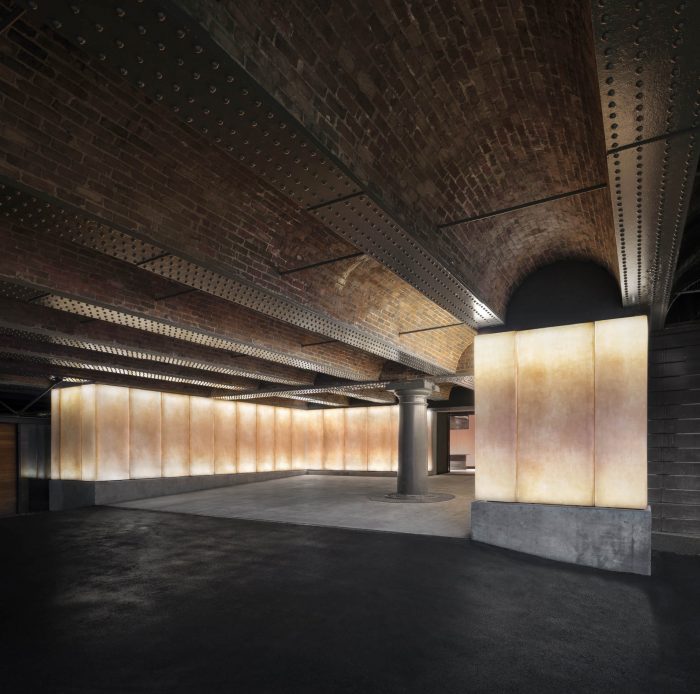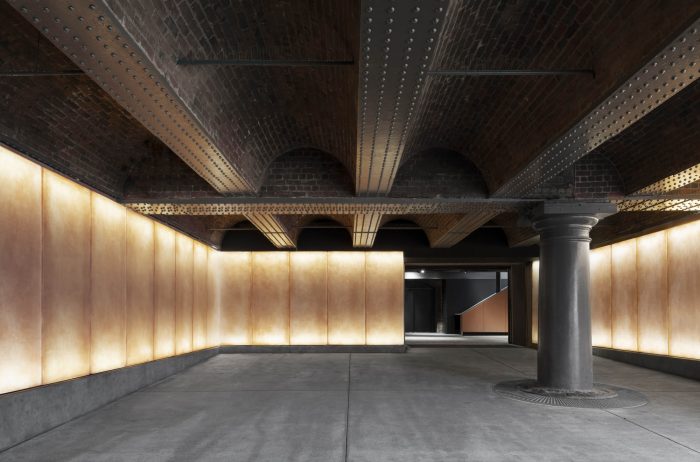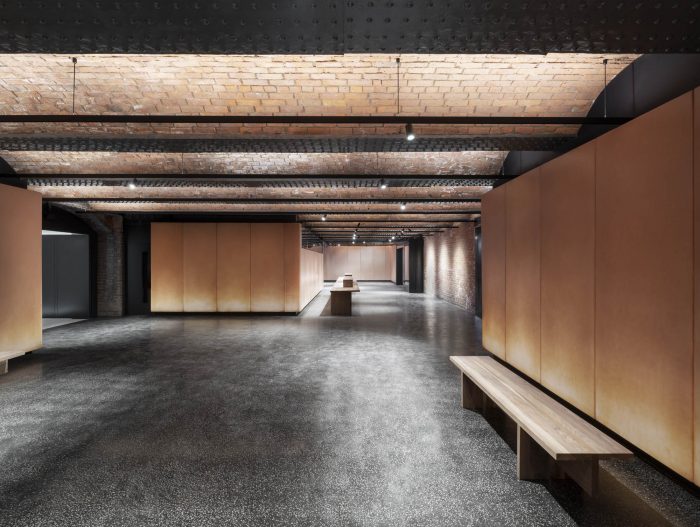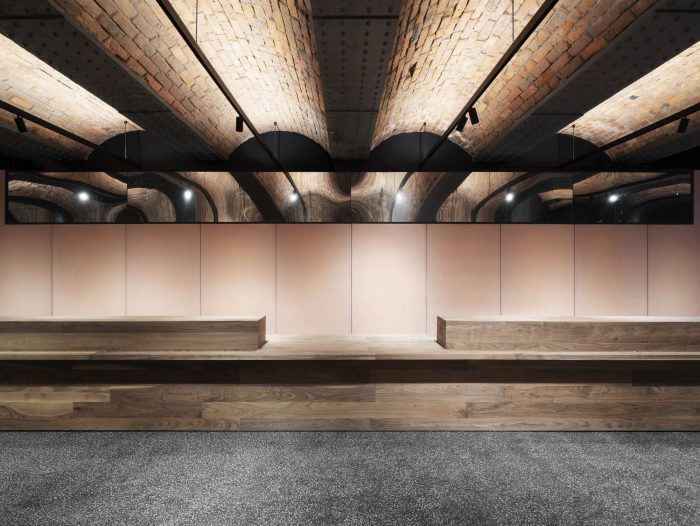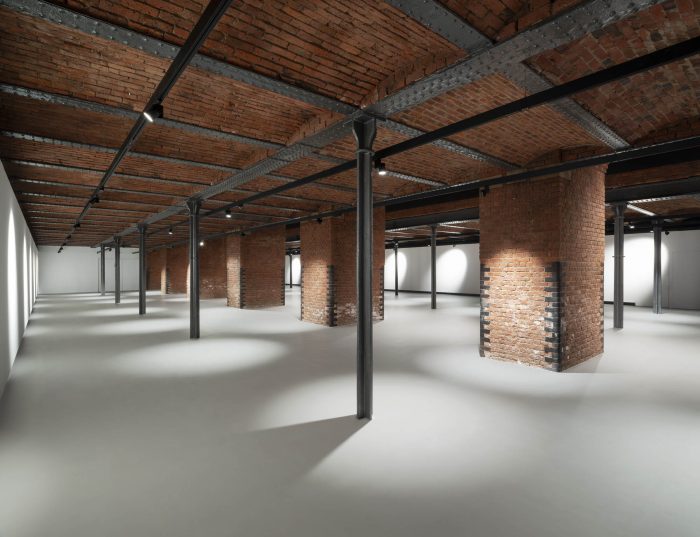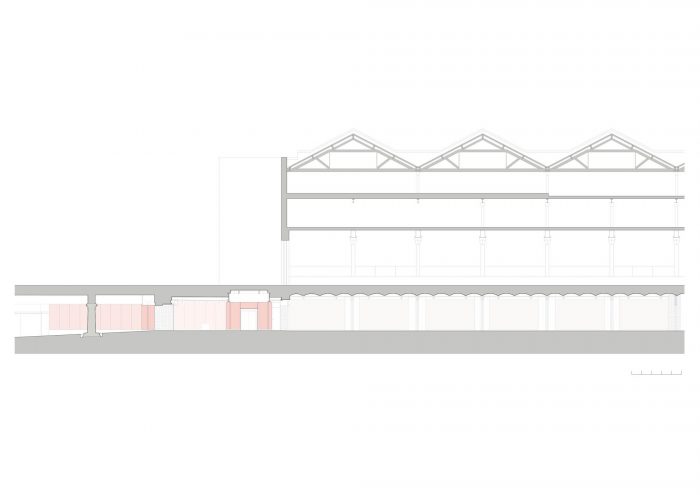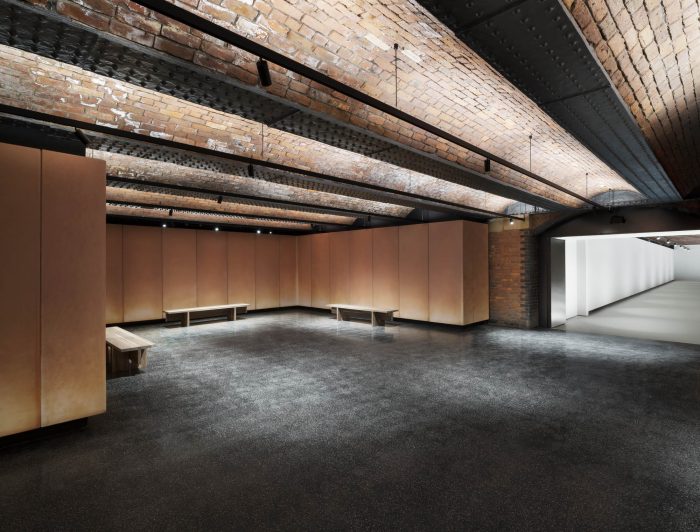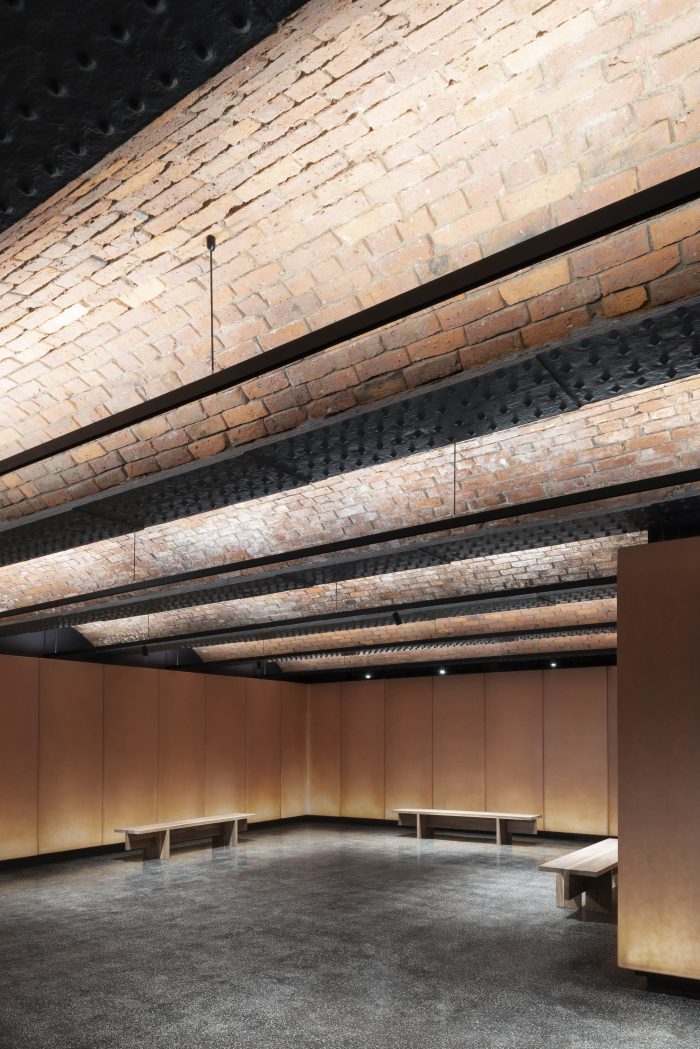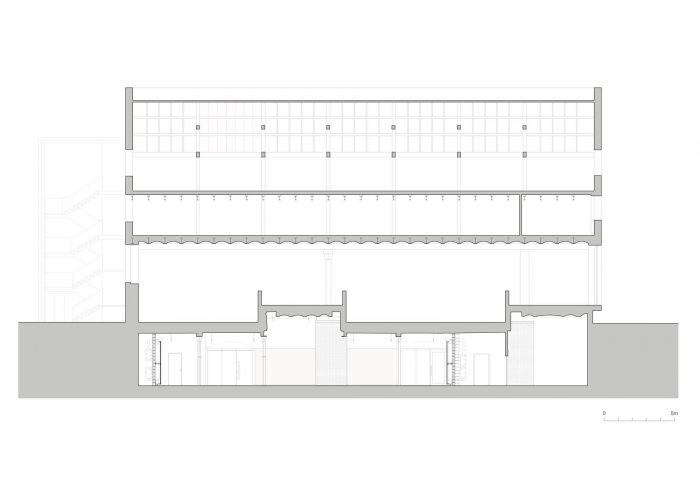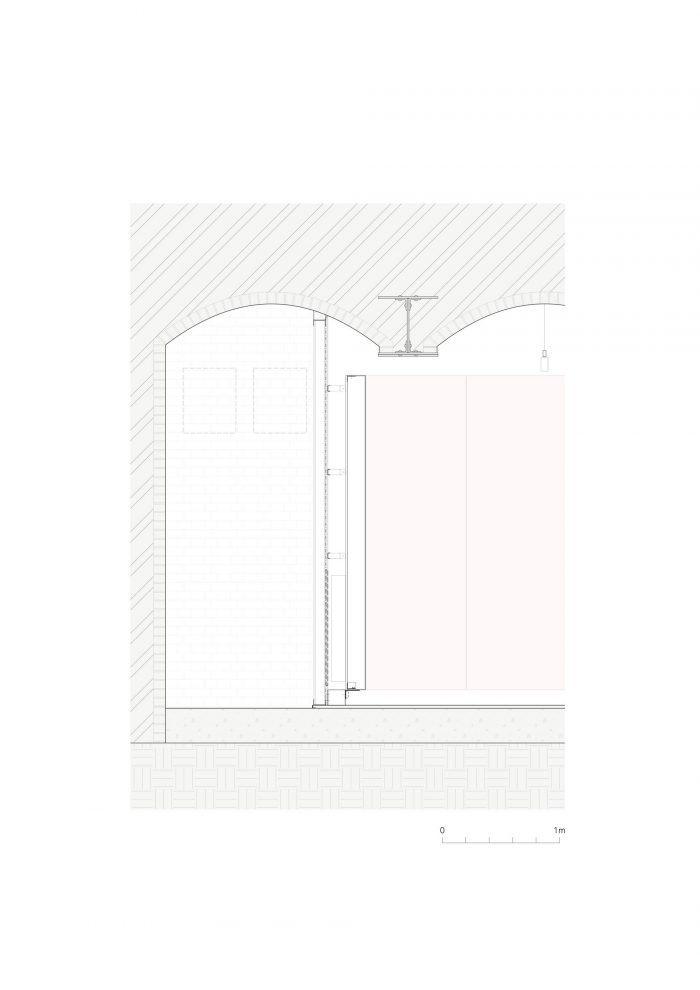画廊位于新仓库的底层,新仓库是一座二级建筑,可追溯到19世纪80年代。在未来的几年里,博物馆的目标是在现有的历史建筑和空间及其维多利亚时代的铁路高架桥网络之间建立更强大的全场定位和通道。特别展览馆项目创造了一条新的参观路线,将下院和上面最繁忙的博物馆楼层连接起来。同时,它也首次开放了作为画廊空间的公共通道,让公众可以进入博物馆这个具有全球意义的地方。
The gallery is located on the lower ground floor of the New Warehouse, a Grade II listed structure, dating back to the 1880s. In the coming years, the museum aims to create stronger site-wide orientation and access between the existing historic buildings and spaces and its network of Victorian railway viaducts. The Special Exhibitions Gallery project creates a new visitor route, which links the Lower Yard with the busiest levels of the museum above. It also opens-up public access as a gallery space to this part of the museum’s globally significant site for the first time.
从博物馆下院的新入口修复了历史上的高架桥的拱顶下,也就是 “菠萝线”(铁轨从上面进入新仓库),现在这个区域变成了一个明亮和欢迎的空间,清晰地引导游客,并提供一个振奋人心的到达。
The new entrance from the museum’s Lower Yard rehabilitates the vaulted under- croft of the historic viaduct, also known as the “Pineapple Line” (over which railway tracks run into the New Warehouse), now transforming this area into a bright and welcoming space, which clearly orientates visitors and provides an uplifting arrival.
全高的玻璃纤维镶板墙将访客接待从外部转变为内部,减轻了头顶上维多利亚时代的沉重结构的视觉重量,这些结构的设计是为了支撑上方货车的重量,并隐藏了一些持续的维护工程,以永久保护历史建筑结构。每块新的玻璃纤维板都是手工铸造的,并染上了赤陶色,以补充周围风化的维多利亚时代砖块。
Full-height, fibre-glass panelled walls transform the visitor welcome from outside to inside, alleviating the visual weight of the heavy Victorian structures overhead, which were designed to support the weight of goods wagons above, and concealing some of the ongoing maintenance works required for care the historic building fabric in perpetuity. Each new fibre-glass panel has been hand-cast and tinted with a terracotta-hue to complement the surrounding weathered Victorian brickwork.
这些板块采用微妙的背光,显示出表面的制造者的痕迹,并柔和地照亮了历史悠久的铸铁和砖砌千斤拱结构的空间和装饰性,形成了上面的铁路基础设施。
The panels are subtly back-lit, revealing the maker’s marks in their surface and to gently illuminate the spatial and decorative qualities of the historic cast-iron and brick jack-arch structures that form the railway infrastructure above.
铁道高架桥下的宽大外部坡道入口为所有参观者提供了无障碍通道,并有助于藏品管理,使博物馆能够展示较大的藏品,同时还提供了专门的藏品准备和处理设施。下院子和 “菠萝线 “高架桥下的区域将在整个场地的总体规划中发挥越来越重要的作用,随着城市这一部分的改造,科学与工业博物馆、工厂和发展中的圣约翰和卡斯尔菲尔德社区之间将有新的连接和入口。
The generous external ramped entrance below the railway viaduct creates step free access for all visitors and assists with collections management; allowing the museum to display larger collection items, with dedicated object preparation and handling facilities also being provided. The Lower Yard and the area below the ‘Pineapple Line’ viaduct will increasingly play a key role in the site-wide masterplan, with new connections and entrances between the Science and Industry Museum, The Factory and the developing St John’s and Castlefield neighbourhoods, as this part of the city is transformed.
在内部,门厅包含了游客欢迎功能和一个大型的开放式活动空间,直接连接到新的特别展览馆。这个新的展览馆充分利用了地下一层巨大的仓库的大小和特点,其复合铸铁和砖结构以及5米高的拱形天花板,遵循了历史上铁路线和月台的轮廓。整个画廊的历史性结构已被揭示和修复,让游客体验到原来仓库空间的宏伟和规模,同时享受新的展览体验。
Inside, the foyer contains visitor welcome functions and a large open-plan events space, which connects directly to the new Special Exhibitions Gallery. This new gallery exploits the size and character of the vast warehouse lower-ground floor with its composite cast-iron and brick structure and 5m-high vaulted ceilings, which follow the profile of historic railway lines and platforms above. The historic fabric throughout the gallery has been revealed and restored, to allow visitors to experience the grandeur and scale of the original warehouse space, whilst enjoying new exhibition experiences.
画廊经过精心设计,支持博物馆藏品的展示,同时也减少了博物馆的能源消耗。尽可能采用被动式环保设计,以降低生命周期成本,节约碳排放,并减少对展览环境的视觉影响。新墙体采用了吸湿性材料,以减少对除湿的需求,并在整个展览中采用了低能耗的展览照明。
The gallery has been carefully designed to support the display of the museum’s collections, whilst also reducing the museum’s energy use. Passive environmental design has been used wherever possible to reduce life-cycle costing, save carbon and to reduce the visual impact on the exhibition environment. New walls are bolstered with hygroscopic mass to reduce need for dehumidification and low energy exhibition lighting has been used throughout.
特别展览馆是科学与工业博物馆耗资数百万英镑的总体规划中第一个要完成的项目,它将保护并进一步开放其具有全球意义的建筑,并将该地的故事以及改变世界的过去、现在和未来的想法生动地展现出来。
The Special Exhibitions Gallery is the first project to be completed in the Science and Industry Museum’s multi-million-pound masterplan, which will conserve and further open up its globally significant buildings and bring to life the story of the site and past, present, and future ideas that change the world.
建筑师:Carmody Groarke
占地面积:1200 m²
年份:2021年
摄影:Gilbert McCarragher
客户:Science Museum Group
地面分包商:Bell Asphalt
门分包商:Robust UK
结构工程师:Price & Myers
服务工程师:Skelly & Couch
成本顾问:Appleyard & Trew
项目管理:Gardiner & Theobald
文物顾问:Heritage Architecture
策划顾问:Deloitte Real Estate
核定检查员:Butler and Young
消防工程师: Design Fire Consultants
主承包商 : HH Smith & Sons
覆膜承包商:Streamline Fibreglass
机电工程分包商:Murray Building Services and Performance Electrical Limited
城市 : 曼彻斯特
国家:英国
Architects: Carmody Groarke
Area: 1200 m²
Year: 2021
Photographs: Gilbert McCarragher
Client:Science Museum Group
Floor Sub Contractor:Bell Asphalt
Door Sub Contractor:Robust UK
Structural Engineer:Price & Myers
Service Engineer:Skelly & Couch
Costs Consultant:Appleyard & Trew
Project Management:Gardiner & Theobald
Heritage Consultant:Heritage Architecture
Planning Consultants:Deloitte Real Estate
Approved Inspector:Butler and Young
Fire Engineer:Design Fire Consultants
Main Contractor::HH Smith & Sons
Cladding Contractor:Streamline Fibreglass
M&E Subcontractor:Murray Building Services and Performance Electrical Limited
City:Manchester
Country:United Kingdom



